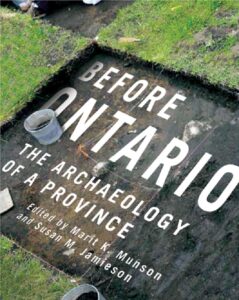Book review: Before Ontario: The Archaeology of a Province
Before Ontario: The Archaeology of a Province is an interesting up-to-date accounting of archaeological knowledge aimed at non-specialists – students or the general public. Overall, the work is an effort to come to terms with past archaeological failings while showcasing current understanding of the past that are influenced by Indigenous knowledge and better use of written documentation. The collection contains 15 articles divided into three sections. All chapters, save one, are written by non-Indigenous archaeological experts who appear to attempt, some more successful than others, Indigenous understandings. The work is unified around the argument that the pre-European past of what became Ontario is filled with humans who lived in complex societies of which archaeology can help us understand only a portion.
“Part 1: A Land before Ontario” offers a basic outline of the various archaeological eras from the first occupants as the icefields retreated, known as Paleoindians, to the peoples of the Archaic and Woodland eras across five chapters. Each chapter explores the key traits and artifacts of the era as well as the interactions between lifestyles and changing environments. Simply, this section follows the Paleoindians’ movement into Ontario, how changing environment led to Archaic peoples’ lifestyles, and eventually, how the adoption of farming further altered landscapes and societies. This section contains the only chapter on the people who lived in what is known as Northern Ontario.
The nine chapters found in “Part 2: Telling Archaeological Stories” are a fun read that explore archaeological interpretations. Each chapter explores a different aspect of archaeological study. For instance, the chapter by Neal Ferris about dwellings discusses how archaeologists interpret the remains of settlements to indicate “how families and communities organized themselves and defined space and place and how those sensibilities changed through times”(Ferris, 111). Another chapter, perhaps the most speculative of the collection, “Social and Political Lives” by Susan M. Jamieson, offers archaeological insights at how social complexity, communal practices, trade, and symbolism evolved through time. Simply, “Part 2” shows the dynamic nature of Indigenous societies yet illustrates how our ancestors continually built on their understandings of the past as experienced through changing living landscapes. This is the best and most interesting section of the collection.
“Part 3: The Last (But Not Final) Word” consists of a single chapter. Kris Nahrgang, the only Indigenous scholar and contributor to the volume, writes a wonderfully human piece that speaks to the past and ongoing problems with archaeologists as well as future promise through change. Nahrgang recognizes the irony illustrated by the collection’s sole Indigenous inclusion coming at the end of the volume of white experts. Regardless, Nahrgang sees the value in archaeology as a decolonized and Indigenized way to learn about our ancestors.
The collection is well illustrated and reflective of the state of archaeological knowledge and interpretation of the pre-European past. Unfortunately, this volume is really about the peoples who lived in what becomes Southern Ontario. It is also full of anachronisms, and perhaps colonizations or ownership claims, when for instance it refers to Indigenous peoples as “Ontarioans” long before Ontario even existed. The constant reference to ancient peoples as a generic covering for anyone or any society prior to 1650 was quite irksome. Despite the anachronisms, lack of Indigenous archaeologists, and general avoidance of people living north of the Upper Lakes, the volume does offer an interesting collective narrative of the dynamic nature of Indigenous studies in what becomes Southern Ontario. I would recommend people read this collection to understand how archaeologists come to understand the Indigenous past, represent this past, and are finally presenting our ancestors living in dynamic societies that seek to address individual, familial, and collective needs.
Marit K. Munson and Susan M. Jamieson, eds. Before Ontario: The Archaeology of a Province. Montreal: McGill-Queen’s University Press, 2013.



